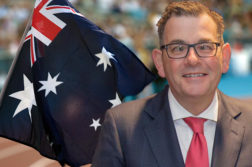Yesterday was the deadline for political parties to lodge an application to be registered in time for the federal election – those that successfully lodged applications will need to wait three months to see if they are successfully registered, but any new applications from today onward won’t be finished in time.
A political party must either demonstrate to the Australian Electoral Commission that they have 500 members who are on the electoral roll, or have at least one member of the Federal Parliament.
While most of the news focused on Clive Palmer’s newly-founded party — and the dramas around the name and the possible inclusion of Peter Slipper — a number of other political parties have been newly formed, and quite a few more are hoping to meet the deadline.
At least seven new parties have successfully registered since the last election, and at least five more are currently awaiting the application process. A number of others were hoping to sign up the requisite 500 members by yesterday, and in the next few days we should find out more about whether these parties have been successful.
There are at least 35 political parties registered for the election, and that number could well exceed 40 before the process has concluded. This is up from 25 at the 2010 election.
Interestingly, many of these political parties can be identified as being “of the left” – whereas in the past a small number of relatively large minor parties such as the Greens and the Democrats have dominated the minor-party left, while the minor-party right have been more divided.
Most of these political parties have never elected an MP, and most of them won’t – so what impact will they have on the election?
Some could have the potential to attract a substantial vote and win seats. Katter’s Australian Party polled over 11 per cent of the vote at the Queensland state election and won two seats. Bob Katter will comfortably retain his seat of Kennedy (QLD), and it is conceivable that other KAP candidates could win, or their preferences could prove vital. The KAP will be a serious factor in the Senate race in Queensland.
Clive Palmer hasn’t been shy in making outrageous claims about becoming Prime Minister, but he’s yet to demonstrate any ability to attract votes or win any seats – it would be a remarkable result if his party could win a single seat.
Apart from these parties, the best another party could hope for is that favourable preferences and luck combine to win them a Senate seat, as Family First’s Steve Fielding and the Democratic Labor Party’s John Madigan achieved in Victoria in 2004 and 2010 respectively.
Most of these parties consist of little more than a name – rarely do they have members who will go out and organise and campaign in multiple seats, and will struggle to have campaign volunteers to hand out how-to-vote cards at any more than a handful of polling places.
They won’t have the money to run more than a handful of ads, and will get minimal media attention. The best chance they have to get votes is to get a favourable position on the Senate ballot paper, and for voters to be attracted to their name and vote for them.
The Senate voting system helps encourage parties with very low profiles, by allowing them to control their preferences. If you vote “1” for a party above the line, your vote flows according to their preference decisions, without you being aware of what those preference decisions are. Parties don’t need to be at the gate of the polling booth to hand you a how-to-vote in order to ensure you direct preferences the way that they want.
If a large number of parties run, and swap preferences, a very small vote for a party can accumulate into enough votes that, with a bit of luck, they could overtake one of the bigger parties and win a seat. Senator Fielding and Senator Madigan were both elected using this tactic in 2004 and 2010 respectively.
This often means that very small parties will get together and make decisions about preferencing each other even when their voters wouldn’t consider voting for one of those other parties before the major parties.
These tactics reached their peak at the 1995 and 1999 New South Wales state elections. The Legislative Council elects 21 members at each election, meaning someone can get elected on less than 5 per cent.
Over eighty groups stood, creating the infamous “tablecloth ballot”. Many of these parties had names that hid the real agenda of those who ran on that party’s ticket, or the people that they preferenced.
In the end, this network of shadow parties provided enough preferences to elect Malcolm Jones of the Outdoor Recreation Party off 0.2 per cent of the vote.
After this experience, New South Wales abolished the preference system that is still used in the Senate. Now if you vote “1” for a party above the line in NSW upper house elections, the preference only flows to the candidates in that group, and no further.
Most of the parties created for this election have a genuine political agenda, and most are relatively honest about their political links. But for many parties the lure of gaining enough preferences to win a Senator outweigh political principle, and we could well see a large number of minor parties allying together against the major parties in the hope that one of them could gain enough preferences to win a seat.
Donate To New Matilda
New Matilda is a small, independent media outlet. We survive through reader contributions, and never losing a lawsuit. If you got something from this article, giving something back helps us to continue speaking truth to power. Every little bit counts.



